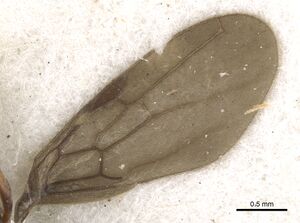Cryptopone motschulskyi
| Cryptopone motschulskyi | |
|---|---|

| |
| Scientific classification | |
| Kingdom: | Animalia |
| Phylum: | Arthropoda |
| Class: | Insecta |
| Order: | Hymenoptera |
| Family: | Formicidae |
| Subfamily: | Ponerinae |
| Tribe: | Ponerini |
| Genus: | Cryptopone |
| Species: | C. motschulskyi |
| Binomial name | |
| Cryptopone motschulskyi Donisthorpe, 1943 | |
Identification
Distribution
Latitudinal Distribution Pattern
Latitudinal Range: -3.324166667° to -8.75°.
| North Temperate |
North Subtropical |
Tropical | South Subtropical |
South Temperate |
- Source: AntMaps
Distribution based on Regional Taxon Lists
Indo-Australian Region: New Guinea (type locality).
Distribution based on AntMaps
Distribution based on AntWeb specimens
Check data from AntWeb
Countries Occupied
| Number of countries occupied by this species based on AntWiki Regional Taxon Lists. In general, fewer countries occupied indicates a narrower range, while more countries indicates a more widespread species. |

|
Estimated Abundance
| Relative abundance based on number of AntMaps records per species (this species within the purple bar). Fewer records (to the left) indicates a less abundant/encountered species while more records (to the right) indicates more abundant/encountered species. |

|
Biology
Castes
Queen
Images from AntWeb
    
| |
| Holotype of Cryptopone motschulskyi. Queen (alate/dealate). Specimen code casent0902461. Photographer Will Ericson, uploaded by California Academy of Sciences. | Owned by NHMUK, London, UK. |
Nomenclature
The following information is derived from Barry Bolton's Online Catalogue of the Ants of the World.
- motschulskyi. Cryptopone motschulskyi Donisthorpe, 1943a: 167 (q.) NEW GUINEA (Indonesia: Waigeu I.).
- Type-material: 2 syntype queens.
- Type-locality: Indonesia: Irian Jaya (“N Dutch New Guinea”), Waigeu, Camp Nok, 2500 ft, v.1938, no. 37 (L.E. Cheesman).
- Type-depository: BMNH.
- Status as species: Donisthorpe, 1943d: 434; Chapman & Capco, 1951: 53; Wilson, 1958d: 359; Bolton, 1995b: 166.
- Distribution: Indonesia (Irian Jaya), Papua New Guinea.
Description
References
- Donisthorpe, H. 1943a. Descriptions of new ants, chiefly from Waigeu Island, N. Dutch New Guinea. Ann. Mag. Nat. Hist. 11(10): 167-176.
- Schmidt, C.A. & Shattuck, S.O. 2014. The higher classification of the ant subfamily Ponerinae (Hymenoptera: Formicidae), with a review of ponerine ecology and behavior. Zootaxa 3817, 1–242 (doi:10.11646/zootaxa.3817.1.1).
References based on Global Ant Biodiversity Informatics
- CSIRO Collection
- Chapman, J. W., and Capco, S. R. 1951. Check list of the ants (Hymenoptera: Formicidae) of Asia. Monogr. Inst. Sci. Technol. Manila 1: 1-327
- Donisthorpe, Horace. 1943. Descriptions of new Ants, chiefly from Waigeu Island, N. Dutch New Guinea. Annals and Magazines of Natural History. 11(9):167-176.
- Donisthorpe, Horace. 1943. The Ants of Waigeu Island, North Dutch New Guinea. The Annals and Magazine of Natural History 11 (10): 433-475.
- Janda M., G. D. Alpert, M. L. Borowiec, E. P. Economo, P. Klimes, E. Sarnat, and S. O. Shattuck. 2011. Cheklist of ants described and recorded from New Guinea and associated islands. Available on http://www.newguineants.org/. Accessed on 24th Feb. 2011.
- Room P. M. 1975. Diversity and organization of the ground foraging ant faunas of forest, grassland and tree crops in Papua Nez Guinea. Aust. J. Zool. 23: 71-89.
- Snelling R. R. 2000. Ants of the Wapoga river area, Irian Jaya, Indonesia. In Mack, Andrew L. and Leeanne E. Alonso (eds.). 2000. A Biological Assessment of the Wapoga River Area of Northwestern Irian Jaya, Indonesia. RAP Bulletin of Biological Assessment 14, Conservation International, Washington, DC.
- Wilson E. O. 1958. Studies on the ant fauna of Melanesia III. Rhytidoponera in western Melanesia and the Moluccas. IV. The tribe Ponerini. Bulletin of the Museum of Comparative Zoology 119: 303-371.
- Wilson E. O. 1959. Some ecological characteristics of ants in New Guinea rain forests. Ecology 40: 437-447.
- Wilson Edward O. 1959. Adaptive Shift and Dispersal in a Tropical Ant Fauna. Evolution 13(1): 122-144

